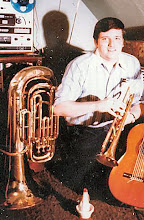1960 - Coral Records CRL 757487 Stereo / CRL 57487 Mono
Side 1
1. The Christmas Song
2. Santa Claus Medley
3. Winter Wonderland
4. Let It Snow, Let It Snow, Let It Snow
5. Blue Christmas
6. Candy Clarinet
Side 2
1. Jingle Bell Rock
2. I'll Be Home For Christmas
3. The Little Drummer Boy
4. Silver Bells
5. White Christmas
6. Christmas Is A-Comin' (May God Bless You)
Liner Notes:
"Candy Clarinet" Merry Christmas for Pete Fountain.
Candy Clarinet?
Well. there is a time of year, isn't there, when the demand for licorice sticks appreciably declines and sales graphs of candy walking canes zoom madly upwards?
Everyone knows when that is. So, in anticipation of December 25th, here is Pete Fountain's clarinet, candy-striped, holiday delivered and Christmas-wrapped, to brighten up the festivities in New Orleans style.
Pete came up with a joyful program of Christmas favorites - all the big ones like Jingle Bells, Silver Bells, White Christmas, The Christmas Song, and Santa Claus is coming to Town, and added some that are less familiar, but good, including an original authored by "Bud" Dant and himself. It's titled if you've not guessed, is 'Candy Clarinet!
The numbers, in fact, seem to cover every possible eventuality in a swinging holiday season. They announce that both Santa Claus and Christmas are coming, and they bring on the sound of the little drummer boy, not to mention two kinds of bells. Songwrites Sammy Cahn and Jules Styne having expressed a popular sentiment in Let It Snow! Let It Snow!, it is hardly surprising that a Winter Wonderland and a White Christmas should result. But how about Blue Christmas? Be not concerned. Just wait until you hear how that candy-stiped clarinet fixes it. Then there ia the assurance that I'll Be Home For Christmas, which really finds it's complement in The Christmas Song by Mel Torme and Rubert Wells, the sub-title of which is Merry Christmas To You.
The collection is another example of Pete Fountain's versatility. His familiar sound and phrasing are very audibly here, but they are flexibly adapted to fit a new need and a new situation. In the public imagination, the jazz musician is perhaps not exactly the type expected the jolly chores of Santa Claus, yet his charitable instincts are probably as well developed as those of any other member of society. Certainly, there is no questioning the good will expressed through his Candy Clarinet.
It is that instrument, needless to say, which leads the revels. Pete has always had a special gift for providing good cheer, whether it is in New Orleans, Nashville, Los Angeles, or the Winter Wonderland, and here he really shines. On most tracks, too, he is superbly supported by an outstanding vocal group, which brings new zest and know-how to some of the more time-honored selections. And always underneath there is an expert rhythm section, giving performances impetus and a beat - and, in one case, a rock!
This is music made for a happy time. It is music to accompany the feasting and gift giving. It is music to relax to after the children have gone, exhausted, to bed, It is music to dance to after all the day's joyous duties are done. And what it keeps repeating in many different ways, but very clearly is:
Merry Christmas for Pete Fountain.













